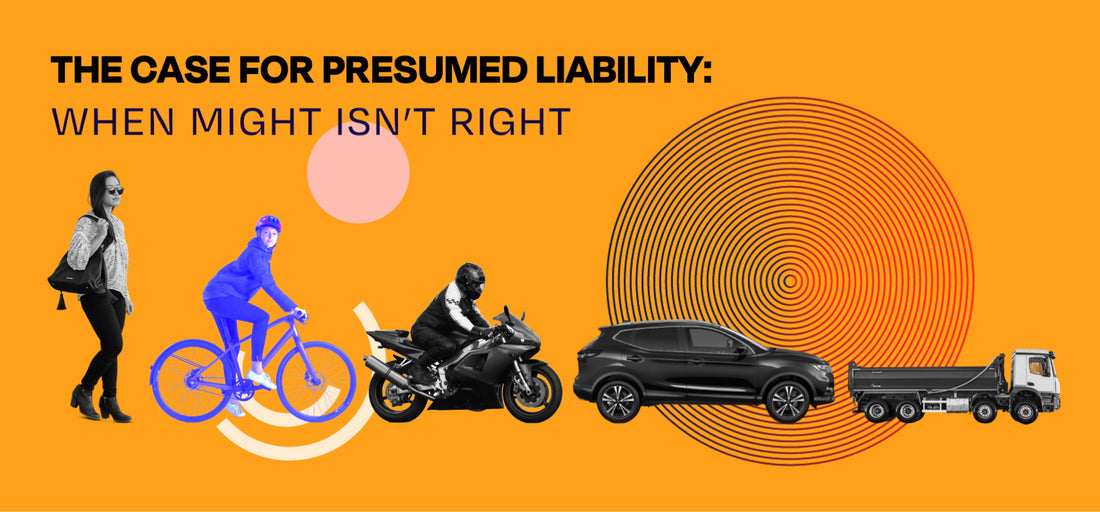
UK cycling's thriving - but it should be in even better health
Share
The UK must write into its legislation a duty of care for everyone on the roads to look after a more vulnerable road user.
Cycling in the UK has gone through a very well documented boom over recent years. Propelled by rising health awareness, the move towards sustainable forms of transport and increased investment in cycling infrastructure, more people in the UK cycled in 2020 than in a generation. Some of the component numbers are startling:
- The total number of miles ridden increased by 30% between 1998 and 2018.
- There was a 185% increase in women’s cycling between 2013 and 2019. This equates to an additional 1,000,000 women riding at least weekly.
- The number of bikes entering Central London daily in 2018 was 160,000 compared to just 55,000 in 1998.
- Covid has put an extra 1,000,000 cyclists on the road.
But it’s not all rosy
Before we start thinking the job’s done, there’s a single set of figures that casts all this progress into sharp relief: of the c. 500 billion miles travelled by UK passengers in a year, only 2% of all trips are undertaken on bicycles (2017).
That’s above Spain and Portugal but it’s a lot lower than nearly everywhere else in Europe. The equivalent ‘modal share’ in France is 4%, it’s 5% in Italy, 7% in Ireland, 12% in Germany, 16% in Sweden, and a (predictably) massive 27% in Holland.
Women are particularly under-represented. 73% of cycling trips in London are made by men, and men ride three times more often and four times as far across the UK as a whole. Only 12% of women ride at least weekly.
Why the disparity between women and men?
SUSTRANS research consistently identifies 6 primary reasons for why fewer women ride, and why they ride less often and less far:
1. Intimidating & hostile traffic environment
2. Confidence in riding skills
3. Sweaty, messy appearance post ride
4. Lack of fitness
5. Age
6. Confidence in fixing equipment
Whilst men also cite these same reasons for not riding, they generally admit to being less intimidated by the traffic and to having greater confidence in their abilities. This disparity has been referred to as a ‘confidence gap’ rather than a ‘competence gap.’
Encouragingly, there are a host of Central and Local Government, and third party initiatives aimed at addressing all of these issues in various ways. The most visible shift has been the huge increase in the number of cycle lanes over recent years. Properly implemented (i.e. segregated), they promote enormous increases in cycle traffic. Whilst London as a whole saw a 5% overall rise in cycling in 2018, well designed cycle lanes such as London’s Green Lanes route stimulated increases of over 50%.
However, on top of continuing to substantially improve the infrastructure, more can still be done to make the roads less challenging and aggressive.
The case for the carrot and the stick
Poor road infrastructure is a big problem but the poor behaviour of other road users is a bigger problem. A look at ROAD.CC’s ‘Near Miss of The Day’ feature shows that they’re up to 574 video documented cases of terrible driving close to cyclists and counting. Many of these incite a queasy feeling in even the most experienced and confident of cyclists.
It is true that the majority of this poor behaviour is down to lack of awareness and entrenched bad habits but there are some divergent views as to how both awareness and habits can best changed.
CARROTS
The carrot approach calls for more training and education of non-cyclists. Strong proponents of this approach, The AA have placed their considerable resources behind their Think Bikes! campaign for the last 6 years. They also support Bikeability road cycling courses for driving instructors to help them better educate new drivers to share the roads, and they support changes to the Highway Code.
STICKS
Other parties such as Chris Boardman - Greater Manchester’s Cycling & Walking Commissioner as well as policy advisor to British Cycling, and who does support The AA’s work - are proponents of legislative changes also. Key amongst these proposed changes is the introduction of the concept of ‘Presumed Liability.’
Presumed Liability establishes a clear hierarchy of road users in road traffic collisions in which the less vulnerable road user is considered to be liable, unless they can establish that the other party was at fault. For example, the driver of a car would automatically be held liable in an incident involving a cyclist, while the cyclist would be liable in a case where a pedestrian was injured. At present, the burden of proof lies with the more vulnerable road user and the disadvantages to vulnerable road users of this approach are clear:
- Cyclists and pedestrians are far more prone to head injuries that can affect their recollection of an accident
- The driver can fall back on the insurer to deal with all compensation claims. Cyclists rarely have third party insurance so typically need to proactively seek representation thus exposing themselves to significant financial risks and a laborious, difficult process
- The fault-based system fails to take into account the underlying power dynamic on the roads, and the driver’s capability to cause substantial harm. The inherent, and much higher risk of risk of driving a vehicle vs. walking or cycling is ignored
The UK is presently one of only 5 countries in Europe that does not operate Presumed Liability - the others being Ireland, Malta, Cyprus and Romania. Opponents argue that it would encourage more ‘hit and run’ traffic accidents but there are no data to support this assertion. This did not happen in France in the 1980s – one of the last big European nations to change their laws. However, there are data that show that countries which boast both high levels of cycling and low casualty rates have some form of presumed liability legislation in place. For many, it’s been a staple of their traffic regulations for decades.
Shift the status quo
Just in the way that Climate Change was not taken seriously until legislation was introduced to force changes in policy and behaviour, Vaela believes that the UK must adopt a carrot and stick approach to changing the behaviour of road users and hence diminish one of the key barriers inhibiting the uptake of cycling – especially by women.
Training, education and ‘nudging’ will not change the behaviour of road users quickly enough if the Government wishes to get close to its aim of ‘making walking and cycling the natural choice for shorter journeys.’ We need to further help make people less apprehensive about cycling on roads, and we need to write into our legislation a duty of care for everyone on the roads to look after a more vulnerable road user. We need presumed liability.
(Sources: Sustrans, Road Share, CyclingUK, GOV.UK, European Cyclists' Federation)
